
Pro tips on catching the “in between” fish
This time of year, bass fishing can be great across the Carolinas. But it can be frustrating too, depending on many factors. Most largemouth bass have completed spawning, but some late spawners are still out there.
It’s what pro bass angler Brian Latimer calls the “in between,” and while he acknowledges it can be a difficult time to fish, he’s got some tips that can make it very productive.
“This time of year, in the late spring, the fish are in a little stage where they are in between everything. They’re not really spawning, they’re not really in the post-spawn, they’re not really stacked up in the summer stuff really good. It’s what I like to call the pre-post-spawn,” said the Belton angler.
Latimer learned how to catch fish this time of year with some tricks his dad taught him years ago.
One important step in catching fish right now is to have a good, quality pair of polarized shades, he said. You’re not always looking for bass to cast to, but it is important to find certain things under the water to know where to cast.
“You have to have a good pair of sunglasses. You’ve got to be able to see those inconsistencies between clay to sand, sand to clay or rock to boulder to pebble. You have to be able to see where to cast,” he said.
Pointing between his boat and the shore, Latimer points out areas near the shallow water that alternate between light and dark.
“Any of these little light and dark spots is where the fish spawn at, and what we’re doing is just blind casting to any of this stuff we see. We get on these shallow flats and shallow bars, and cast to these areas with lures like a Z-Man FattyZ. We’ll catch spawning fish, some that are cruising, post-spawn fish; there’s a little bit of everything out on all these flats,” he said.
Latimer said it’s also important to be able to recognize the area where you can see the bottom meeting with the area that you just can’t quite see.
“A lot of the fish are going to be hanging out right where you can’t see the bottom anymore. Where you see light areas touching dark areas, those dark areas make the fish feel safe. They feel like they’re hidden. And this is the one time I would say it’s okay to go ahead and make a cast directly on the dark spots, because you kind of want to surprise them,” he said.
This will often cause a reaction strike as opposed to retrieving a lure past the fish, giving it time to get a good look at it.
And even though most of the bass are either done with spawning, plenty of fish are still hanging out in the same areas as spawning fish while they wait to make their next big move.
“If a bass has the option, it will always spawn beside something, and if it can’t, then the next option is to spawn in these dark spots. They seem to feel safe and comfortable there,” he said.
Because your ability to see into the water is so important with this type of fishing, Latimer said it’s best to find the clearest water in your lake or reservoir.
Latimer primarily uses spinning gear when fishing this way, and threads the FattyZ onto a 1/6-ounce Z-Man Power Finesse Shroomz jighead, then places a small bit of Super Glue between the jighead and the lure.
While fishing is a passion that Latimer has enjoyed since he was old enough to hold a fishing rod, he’s just as passionate about sharing the angling experience with others and helping them catch fish. He does a lot of angler development projects, including sharing fishing tips and tactics on his YouTube channel. Click here to see more.





Be the first to comment